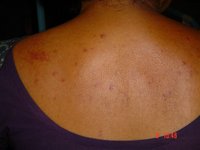In idiopathic thrombocytopenic purpura (ITP), the destruction of platelets by antiplatelet autoantibodies results in platelet phagocytosis by the spleen and reticuloendothelial system. The consequent risk of fatal bleeding in adults ranges from 0.4 percent to 13 percent per year, depending on patient age. The usual first-line treatment is corticosteroids, but because the spleen is the principal site of autoantibody production and platelet destruction, splenectomy is an effective second-line treatment. Gadenstatter and colleagues studied the role of splenectomy in the treatment of patients with ITP.
The study included 92 patients with ITP who presented to the hematology and oncology department of an Austrian university between 1991 and 2000. The median age of the 33 men and 59 women was 49 years (range: 15 to 93 years). All patients had laboratory-confirmed thrombocytopenia, and most had hemorrhagic symptoms with no plausible explanation except ITP. All patients initially were treated medically. Seventy-eight patients (85 percent) received glucocorticoid therapy alone. A combination of glucocorticoid and immunoglobulin treatment was used in nine patients (10 percent), and the remaining five patients (5 percent) had pulsed high-dose dexamethasone, immunoglobulin, or vinblastine therapy alone. Splenectomy performed by midline laparotomy was used when patients did not respond well to medical treatment, had severe bleeding, or developed complications from medical treatment.
The 38 patients (41 percent) who underwent splenectomy had a median interval of seven months of medical therapy (range: two to 13 months). Follow-up was completed in 91 patients (99 percent) after a median of 64 months (range: 46 to 117 months).
During medical therapy, side effects were documented in 32 patients (35 percent). The most common adverse effects involved cutaneous effects on the skin, but Cushingoid changes, gastrointestinal upset, myopathy, weight gain, hypertension, and osteoporosis were also common. Only two patients (5 percent) had complications resulting from surgical treatment. Complete remission (normal platelet count and no further therapy required) was achieved in 15 patients (16 percent) who received medical therapy and 33 patients (87 percent) who had splenectomy. Partial remission (nearly normal counts and no therapy required) was documented in 12 patients (13 percent) who were treated medically and two patients (5 percent) who were treated surgically. Overall, 64 patients (70 percent) failed to respond to medical therapy, and three patients (8 percent) failed to respond to splenectomy. In a stepwise logistic multivariate analysis, only patient age and splenectomy correlated with complete or partial remission.
The authors conclude that splenectomy is an effective and safe treatment of ITP, especially in younger patients, and exposes patients to fewer potential treatment-related adverse effects. They believe that laparoscopic splenectomy offers additional benefits but that a careful search must be made for accessory spleens that may be present in up to 20 percent of cases.
EDITOR'S NOTE: If the therapeutic pendulum swings back to splenectomy as the preferred treatment for a substantial proportion of patients with ITP, family physicians will become these patients' "safety net" for remembering their vulnerability to other autoimmune diseases and to severe infections, particularly those caused by Pneumococcus. Following splenectomy for ITP, patients need lifelong special attention to disease prevention and early detection of potential problems. I am surprised constantly by how many patients are found to have significant medical problems that they have forgotten about or that have not been recorded in their medical chart. Nothing beats asking the patient, but it is not unusual for them to recall surgeries only when asked about obvious scars. What will we do when laparoscopic surgeries become even more common and our eyesight fades?--A.D.W.
COPYRIGHT 2003 American Academy of Family Physicians
COPYRIGHT 2003 Gale Group



